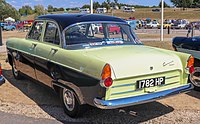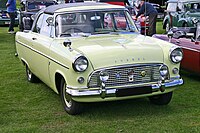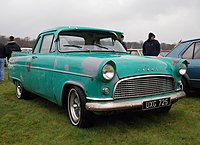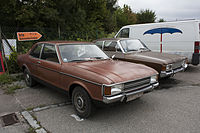
The Ford Anglia is a small family car that was designed and manufactured by Ford UK. It is related to the Ford Prefect and the later Ford Popular. The Anglia name was applied to various models between 1939 and 1967. In total, 1,594,486 Anglias were produced. It was replaced by the Ford Escort.

The Ford Taunus is a family car that was sold by Ford Germany throughout Europe. Models from 1970 onward were built on the same basic construction as the Ford Cortina MkIII in the United Kingdom, and later on, the two car models were essentially the same, differing almost only in the placement of the steering wheel. The model line was named after the Taunus mountain range in Germany, and was first made in 1939, and continued through several versions until 1994.
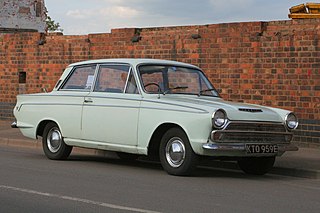
The Ford Cortina is a medium-sized family car manufactured and marketed initially by Ford of Britain, and then Ford of Europe in various body styles from 1962 to 1982 over five generations — and was the United Kingdom's best-selling car of the 1970s.
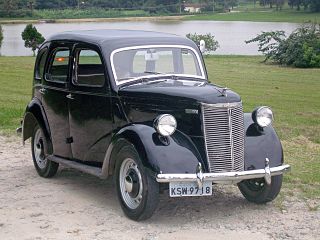
The Ford Prefect is a line of British cars which was produced by Ford UK between 1938 and 1961 as an upmarket version of the Ford Popular and Ford Anglia small family cars. It was introduced in October 1938 and remained in production until 1941. Returning to the market in 1945, it was offered until 1961. The car progressed in 1953 from its original perpendicular or "sit-up-and-beg" style to a more modern three-box structure. Some versions were also built and sold by Ford Australia.

The Essex V4 is a V4 petrol engine manufactured by the Ford Motor Company from 1965 to 1977. The engine was available in both 1.7 L and 2.0 L capacities. Designed by Ford of Britain, the Essex V4 was produced at a plant in Dagenham, originally in the county of Essex, later part of east London. The engine was used in the Ford Corsair, Capri Mk I, Consul/Granada Mk I, Ford Zephyr Mk IV and the Ford Transit Mk I van.
The name Ford Corsair was used both for a car produced by Ford of Britain between 1963 and 1970, and for an unrelated Nissan-based automobile marketed by Ford Australia between 1989 and 1992.

The Ford Consul Classic is a mid-sized car that was launched in May 1961 and built by Ford UK from 1961 to 1963. It was available in two or four door saloon form, in Standard or De Luxe versions, and with floor or column gearshift. The name Ford Consul 315 was used for export markets. The Ford Consul Capri was a 2-door coupé version of the Classic, and was available from 1961 until 1964.

The Ford Zephyr is an executive car manufactured by Ford of Britain from 1950 until 1972. The Zephyr and its luxury variants, the Ford Zodiac and Ford Executive, were the largest passenger cars in the British Ford range from 1950 until their replacement by the Consul and Granada models in 1972.

The Ford Essex V6 engine is a 60° V6 engine built between 1966 and 1988 by the Ford Motor Company in the United Kingdom and until 2000 in South Africa although mostly in the Ford engine plant of Dagenham, Essex, which gave the engine its name. It is closely related to the Ford Essex V4 engine produced in displacements of 1.7 L and 2.0 L. Both engines share many parts since the Essex V6 was directly derived from the Essex V4; the 2.0 L Essex V4 and the 3.0 L Essex V6 in fact have exactly the same bore and stroke and share various components. In the same era, the Ford Cologne V6 engine was produced.
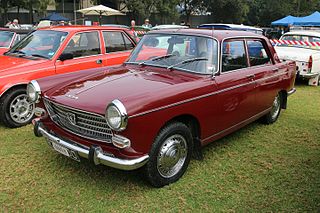
The Peugeot 404 is a large family car produced by French automobile manufacturer Peugeot from 1960 to 1975. A truck body style variant was marketed until 1988. Styled by Pininfarina, the 404 was offered initially as a saloon, estate, and pickup. A convertible was added in 1962, and a coupé in 1963. The 404 was fitted with a 1.6 litre petrol engine, with either a Solex carburetor or Kugelfischer mechanical fuel injection or a 1.9 litre diesel engine available as options. Introduced at the Paris Motor Show as an option was the inclusion of a 3-speed ZF automatic transmission, similar to the unit already offered on certain BMW models, as an alternative to the standard column-mounted manual unit.

The Triumph Herald is a small two-door car introduced by Standard-Triumph of Coventry in 1959 and made through to 1971. The body design was by the Italian stylist Giovanni Michelotti, and the car was offered in saloon, convertible, coupé, estate and van models, with the latter marketed as the Triumph Courier.

The Lancia Flavia is an executive car produced by Lancia in Italy from 1961 to 1971. Production continued as the Lancia 2000 from 1971 to 1975.

The Ford Escort is a small family car that was manufactured by Ford of Europe from 1968 until 2000. In total there were six generations, spread across three basic platforms: the original, rear-wheel-drive Mk.1/Mk.2 (1968–1980), the "Erika" front-wheel-drive Mk.3/Mk.4 (1980–1992), and the final CE-14 Mk.5/Mk.6 (1990–2002) version. Its successor, the Ford Focus, was released in 1998, but the final generation of Escort was phased out gradually, with the panel van version ending production in 2002 in favour of the Ford Transit Connect.
Carbodies was a taxi design and manufacturing company based in Coventry, England. In its latter years it also traded as London Taxis International and The London Taxi Company.

Crayford Engineering was an automobile coachbuilder based in Westerham, Kent, England and formed in 1962 by Jeffrey Smith and David McMullan, (sales). In the 1970s, a subdivision within the company, called Crayford Auto Developments, Ltd., was established for automobiles. The company specialized in converting European coupés and saloons into convertibles and estates. Notable products included the convertible Mini, BMC 1100/1300 convertible, convertible Corsair, Cabriolet Corsair, Cabriolet Capri, the rare Triumph TR7 Tracer Estate, and a Princess hatchback conversion, a commonly accepted principle for a car that appeared to be, but was not, a hatchback to begin with. Other lesser-known conversions from Crayford included the Tempest, a convertible Volkswagen Scirocco, a Ford Cortina Mk V Convertible, and a Mercedes S-Class Estate. In 1966 the company converted, for the Heinz food company, 57 Wolseley Hornet Mini-derived cars to convertibles, to be given as prizes in a competition. The cars designed and created by Jeffrey Smith were featured in the Olympic Closing Ceremony in London 2012.
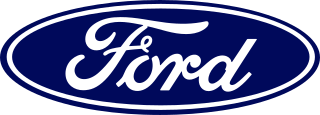
Ford of Europe GmbH is a subsidiary company of Ford Motor Company founded in 1967 in Cork, Ireland, with headquarters in Cologne, Germany.
Abbott of Farnham, E D Abbott Limited was a British coachbuilding business based in Farnham, Surrey, trading under that name from 1929. A major part of their output was under sub-contract to motor vehicle manufacturers. The business closed in 1972.

The European Ford Granada is an executive car manufactured by Ford Europe from 1972 until 1994.

The Vauxhall Velox is a six-cylinder executive car which was produced by Vauxhall from 1948 to 1965. The Velox was a large family car, directly competing in the UK with the contemporary six-cylinder Ford Zephyr, and to a slightly lesser extent, with the A90, A95, and A110 Austin Westminster models.

The Cortina Savage is a custom performance automobile based on the Ford Cortina. The car was designed and produced by Jeff Uren and his companies, Race Proved Performance and Racing Equipment Ltd., and Jeff Uren Ltd. Production of the conversion started in the mid-1960s and was applied to multiple generations of the Cortina, with the Mk2 Savage built in the largest numbers.














